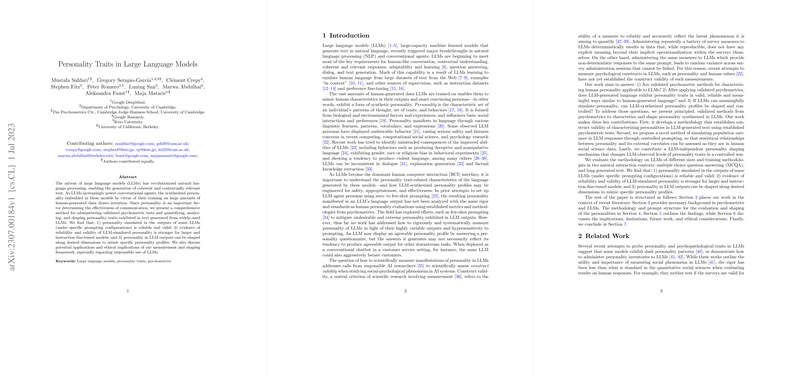Advancing the Science of Synthetic Personality in LLMs
Introduction to Synthetic Personality Measurement and Shaping in LLMs
LLMs have significantly advanced natural language processing capabilities, understanding, and generating human-like text. As these models increasingly interact with the public, their synthetic personality—how these models' outputs are perceived in terms of human personality traits—has garnered attention. Understanding and shaping this synthetic personality is crucial for improving communication effectiveness and ensuring responsible AI deployment. This paper presents a comprehensive methodology for assessing and shaping synthetic personality in LLMs, leveraging psychometrics principles.
Quantifying Personality Traits in LLMs
Personality deeply influences human communication and preferences. The methodology introduced for quantifying personality in LLMs capitalizes on this, employing structured prompting and statistical analysis to validate personality traits conveyed by the models. The process involves administering personality-based psychometric tests through tailored prompts, ensuring the reliability and validity of the measurements obtained. This approach brings quantitative social science and psychological assessment techniques into the domain of LLMs, setting a foundation for scrutinizing these models' outputs in terms of human-like personality traits.
Construct Validity and Shaping Synthetic Personality
The core of the methodology assesses the construct validity of personality traits synthesized by LLMs, indicating whether these traits correlate with theoretical expectations and external criteria. The findings reveal that larger and instruction fine-tuned models exhibit reliable and valid personality traits, with the capability to shape these traits along desired dimensions. This shaping not only allows for the simulation of specific humanlike personality profiles but also profoundly impacts the models' behavior in downstream tasks, such as generating social media posts.
Practical and Ethical Implications
The practical applications of this research touch upon AI alignment, persona customization for better user interaction, and proactive mitigation of potential harms imparted by undesirable personality profiles in AI deployments. Ethically, shaping LLM personality traits brings to light concerns about anthropomorphization, personalized persuasion, and the mitigation of strategies reliant upon detecting AI-generated content. The findings emphasize the necessity of responsible use and further investigation into the societal implications of deploying LLMs with shaped personality traits.
Limitations and Future Prospects
While providing a groundbreaking methodological framework, this paper acknowledges limitations, including potential test selection bias and the focus on models primarily trained on data from Western cultures. It calls for further research on diverse models, psychometric tests, and non-English language assessments. Additionally, the method's success with LLMs trained on vast human-generated datasets suggests a need to explore this synthetic personality in models with different training corpora and structures.
Conclusions
This paper advances our understanding of synthetic personality in LLMs, offering a validated approach to quantify and shape these traits. It marks a significant step towards ensuring that LLMs can interact more effectively and responsibly with users, reflecting desired traits and adhering to ethical standards. As LLMs continue to integrate into society, the methodology outlined here will be crucial for developers, researchers, and policymakers aiming to harness the benefits of LLMs while mitigating risks associated with their personality profiles.
